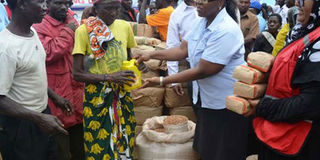Food prices set to rise as State warns of low rains

Kenya Ports Authority (KPA) Managing Director Catherine Mturi-Wairi (second right) gives relief food to Maryango residents in Ganze Sub County on September 25, 2016. Food prices are likely to increase due to low rainfall. PHOTO | KAZUNGU SAMWEL | NATION MEDIA GROUP
What you need to know:
- Experts have blamed the situation on the La Niña phenomenon, which is the opposite of El Nino.
- On Friday, Treasury announced it had released Sh250 million to the State Department of Special Programmes for emergency relief food for affected residents in 23 arid and semi-arid counties.
- Kenya was also included among six countries in East Africa that received Sh8.6 billion last year from the EU to mitigate the effects of the El Nino.
Kenyans should brace themselves for yet another season of depressed and poorly distributed rainfall over most parts of the country, which could impact agricultural production.
This warning comes as the government begins provision of relief food to those affected by the current drought due to failed rains in April.
The Meteorological Department has, in its latest forecast for the October to December short rains season, indicated that at least two-thirds of the country will receive depressed rainfall while the Red Cross has told the Sunday Nation that close to two million people are currently in need of food aid.
Experts have blamed the situation on the La Niña phenomenon, which is the opposite of El Nino.
La Nina, which usually takes place after an El Nino, causes the temperatures in the Pacific Ocean, which is one of the main drivers of weather in the world, to be cooler than average.
Like the El Nino phenomenon, La Nina causes either catastrophic floods especially in Asia and Central America or drier than normal conditions in East Africa.
Acting Director of Meteorological Services Peter Ambeje says it is only the highlands west of Rift valley, Lake Victoria Basin, Central Rift Valley and parts of Nairobi that “are likely to receive near-average rainfall” while the rest of the country will experience depressed or no showers which will affect farming and push up the cost of food.
“During the month of September 2016, cooler than average Sea Surface Temperatures (SSTs) prevailed over western equatorial Indian Ocean (adjacent to the East African coast resulting in reduced moisture influx from the Indian Ocean into the country. This was an indication that La Niña-like conditions are present in the Pacific Ocean,” he says.
“The rainfall forecast for October is based on regression of Sea Surface Temperature Anomalies. Several parts of the Central highlands and Northwestern Kenya are expected to receive near-average to below average rainfall while the entire Northeastern, Southeastern and the Coastal strip are expected to experience highly depressed rains.”
Although the Lake basin regions started receiving rains last month, the rest of the country has been dry which is unusual for the month of September which is traditionally wet and the weatherman says rainfall is not expected in several places until the end of October.
On Friday, Treasury announced it had released Sh250 million to the State Department of Special Programmes for emergency relief food for affected residents in 23 arid and semi-arid counties.
Another tranche (Sh54 million), which is part of 10 million Euros given by the European Union for such occurrences, has been disbursed by the National Drought Management Authority.
However, during the press conference, Treasury CS Henry Rotich and his Devolution and Planning counterpart Mwangi Kiunjuri had a difficult time explaining how money set aside last year to mitigate the effects of El Nino was spent. The government had allocated Sh10 billion.
BAD SITUATION
Kenya was also included among six countries in East Africa that received Sh8.6 billion last year from the EU to mitigate the effects of the El Nino.
“Money is set aside for a purpose and the country did not receive the El Nino as anticipated. Like our Ministry received Sh348 million which we returned to the Treasury,” said Kiunjuri.
There has been concern on how money set aside for disasters is spent due to the duplication of roles between national, county governments and humanitarian agencies which leaves room for misappropriation.
Last year, some counties also set aside as much as Sh50 million for a similar reason but never accounted for the money. Nandi County, in particular, raised eyebrows after it announced setting aside Sh500 million.
“Three years ago, some 2.5 million Kenyans were affected. Now we are talking of less than two million which means we are on top of the situation,” said Mr Rotich.
And although the government says no person has died yet, the Red Cross says the level of malnutrition in a number of counties is critical and could escalate if food distribution is not expedited.
“The Unicef Kenya nutrition situation overview report of October 2016 indicates that the rate of malnutrition is critical, above 20 per cent in four counties (Turkana, East Pokot in Baringo, Mandera and Marsabit), extremely critical at 30.3 per cent in Turkana North and 15 per cent in West Pokot,” Anthony Mwangi, the group’s head of Corporate Affairs, told the Sunday Nation.
“This simply means that one out of four children are malnourished and since malnutrition contributes to half of all deaths in children under five, these children are facing a four to nine fold increased risk of mortality,” he said.
Counties like Kilifi, Kwale, Tana River and Lamu are already witnessing severe vegetation deficit as a result of failed rains in April with the National Drought Management Authority warning that 19 others counties which received depressed rainfall during the long rains are unlikely to receive enough showers till next year.
These are West Pokot, Wajir, Turkana, Tharaka Nithi, Taita Taveta, parts of Nyeri, The northern part of Meru, Mbeere and Garissa. Others include Isiolo , Kajiado, Laikipia, Kitui, Makueni and Mandera.





